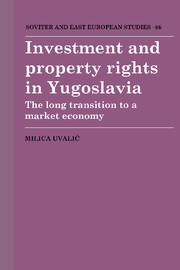Book contents
- Frontmatter
- Contents
- List of figures
- List of tables
- Preface and acknowledgements
- Introduction
- Part I The institutional and theoretical framework
- Part II Empirical evidence on the nature of the Yugoslav system
- Part III Pressure for more radical reforms in Yugoslavia
- 8 Early attempts at introducing investment incentives
- 9 Current property reforms
- 10 Specific features of the Yugoslav transition
- 11 An overview of conclusions
- Notes
- List of references
- Index
- Series list
8 - Early attempts at introducing investment incentives
Published online by Cambridge University Press: 11 January 2010
- Frontmatter
- Contents
- List of figures
- List of tables
- Preface and acknowledgements
- Introduction
- Part I The institutional and theoretical framework
- Part II Empirical evidence on the nature of the Yugoslav system
- Part III Pressure for more radical reforms in Yugoslavia
- 8 Early attempts at introducing investment incentives
- 9 Current property reforms
- 10 Specific features of the Yugoslav transition
- 11 An overview of conclusions
- Notes
- List of references
- Index
- Series list
Summary
In the period before 1965, when the system of mobilizing and allocating investment resources was centrally directed through state investment funds, there was no need for investment incentives at the enterprise level. Following the 1965 reform, decentralization and the desire to introduce a market-oriented system required the creation of new mechanisms which would provide built-in incentives for the enterprise to invest and allocate capital efficiently. Such a requirement led to the elaboration of new concepts by one of the leading politicians of the time, Edvard Kardelj, and to their implementation during the 1970s through a series of new financial instruments.
The views of Edvard Kardelj
Among the various problems that emerged after the 1965 economic reform was that of the increasing concentration of economic power in banks, and the related problem of ‘autonomous’ financial capital. These problems were perceived by the Yugoslav authorities as being directly in conflict with self-management, because they were thought to imply rental income for privileged classes and the deprivation of workers of a part of the income they had produced. Consequently, the economic reform of the 1970s was intended to enable enterprises to appropriate a larger part of income, while reducing the role of banks by introducing new methods of mobilizing savings that would not necessarily require the banks' intermediation.
A lively debate at the end of the 1960s apparently resulted in the victory of economic reasoning over ideology. Investment in capital and entrepreneurship were to be recognized as functions that ought to be rewarded.
- Type
- Chapter
- Information
- Investment and Property Rights in YugoslaviaThe Long Transition to a Market Economy, pp. 157 - 175Publisher: Cambridge University PressPrint publication year: 1992

